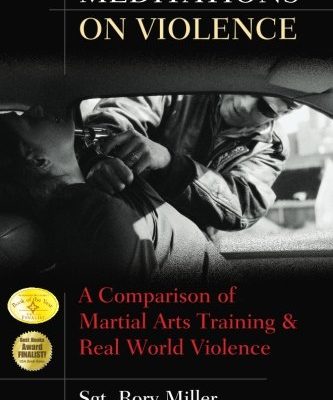
What is the Bookshelf?
It’s very simple! It is a new section of the page. In this section I will gather some of the ideas and opinions that arise from reading books. Not just any kind of books, of course. Only those that have some relationship with karate, martial arts or self protection in general. It is also a way of ‘convincing’ myself of being more consistent and dedicating more time to reading all these texts.
Violence 101
One of the most controversial elements in the practice of martial arts ir the nature of violence. Many times it is “reinvented” (Abernethy 2017) often to the detriment of the relevance of the technique. When we overwrite the reality of violence we falsify the utility of training in this or that way. But, how can we understand violence if we have been priviledged enough not to experience it by ourselves?
The solution
Through the experience of other people! And it is better if they have thought about those experiences. If they have done research, trained and then decided to communicate what they learnt to the world, all the better. This is the case when we talk about Rory Miller, who published the book Meditations on Violence: A Comparison of Martial Arts Training & Real World Violence. Not so long ago I finished reading this book and it is truly a transforming thing to do. Specially if you are thinking about understanding that space that is found between methodology in martial arts and the reality of physical violence. An incredibly revealing book.
The book
Let me tell you why I think this book is outstanding. First of all, it is undeniable that the style of the author, simple and direct, helps making it easy to understand the complexities of a violent situation. It also clearly explains the factors that one has to consider in advance, that is during the preparation to face such a situation.
Secondly, the content of the book is vast and more than enough to cover the basics. It introduces the reader to topics such as the workings of the adrenaline system, or the types of violence and its patterns. It also touches on interesting topics like the kind of mistakes that people can make when training, or the consideration of kata in that training (which is very relevant for fellow karateka).
The fifth chapter is probably one of my favourite ones. It considers several positive ways of working. Not at the technical level though, that is what to do when we suffer this or that attack. This is a general book, it’s not about a martial art in particular. The author focuses on the methodology of training. That is, the framework as well as the appropiate mindset. In my opinion this is the key, since a series of good techniques trained with the wrong methodology will lead us to waste our time. That would be the best case scenario. A series of bad techniques trained with the correct methodology will be modified or abandoned in order to search for more appropiate techniques.
Another key chapter is the next one. It talks about different concepts or principles. The knowledge of these is essential in order to carry out a successful physical defense. The emphasis is on the word ‘physical’. Something that the author repeats throughout the book is that if we get involved in a physical violence situation, that means that ALL our previous strategies have failed. That means that we have to deal with the consequences. It is important to note that an appropiate training system will also take into account and work on these previous strategies (such as awareness or escape).
As a conclusion
Many times in order to protect ourselves in the most effective way we have to change our understading and mentality. This book deals with the mindset changes needed to achieve that objective. It contains all the information about violence that is going to end up being extremely useful in order to perform this mindset shift.
Apart from the content there is a detail about the book that I just love. That detail is the fact that Rory gifts us, the readers, with his own experiences to serve as examples. In many cases those examples helped me understand the more theoretical explanations. He talks not only about those situations that he handled well, but also about mistakes and how he learned from them.
For someone who has been lucky enough not to directly experience this kind of criminal violence, this book is so far one of the best I’ve read in order to understand better the nature of violence. At least as much as can be understood from the distance.
If you liked this article, check out some of the others I have published. Thanks for reading!
Referencias
Abernethy, I. (2017) “Reinventing Violence” en la Iain Abernethy Podcast
https://www.iainabernethy.co.uk/content/reinventing-violence-podcast
El libro
https://www.amazon.com/Meditations-Violence-Comparison-Martial-Training/dp/1594391181